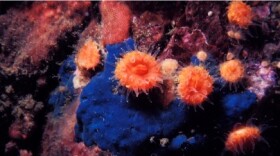It’s one of the more dramatic-sounding aspects of climate change: as carbon emissions and other greenhouse gases speed up global warming, sea levels are expected to rise too.
And the effects will have widespread impacts locally. Tacoma and Island County are among coastal communities in Western Washington that are already considered vulnerable. Both those jurisdictions are partners in a federally-funded coastal resilience project, backed by the National Oceanic and Atmospheric Administration. Scientists working under the umbrella of the University of Washington's Washington Sea Grant program have begun collecting data and developing best practices for planners, to help communities adapt and plan for significant risks.
Right now, there are more questions than answers on this topic. Exactly how much higher will tides rise and what’s a realistic view of the dangers and impacts?
Estimates about sea level rise in Washington range pretty widely. But there are plenty of places around the state that are dry now, but could be submerged by the end of the century.
Tacoma's Examples
Take a drive through the port or walk along the Thea Foss Waterway in Tacoma and you can try to visualize the future.
Jim Parvey, a senior engineer with the city of Tacoma’s office of sustainability, says the Center for Urban Waters on the Thea Foss Waterway provides a pretty good example of what could happen.
How much the waterline rises will depend on a lot of factors, including how much societies are able to curb their carbon emissions. But regardless, he says the pavers outside this modern building — with a green roof and lots environmentally-friendly finishes —are expected to be covered by the end of the century — by as much as four and a half feet of added water.
“We have a range that could go from two inches to 54 inches,” Parvey says. “So it’s not over our eyeballs, but it would certainly be up around our ankles.”
Pilot Communities Demonstrating Spectrum Of Issues
Tacoma has been selected as one of the communities that scientists with Washington Sea Grant will use as a pilot for new studies of sea level rise. Other locations are yet to be named, but will all be in Island County. The county’s sites will provide information about less populated and rural areas, while Tacoma’s urban settings and port infrastructure right on Commencement Bay will demonstrate the more populated and densely-built scenarios. The hope is that the range of information will be useful to all kinds of coastal communities around the state.
Not Just Shorelines
Across from that spot outside the Center for Urban Waters, there are steep wooded bluffs near Commencement Bay. Those are expected to erode more, increasing the risk of landslides. And less than a mile away, there’s a wastewater treatment plant that’s in the flood zone of the Puyallup River. All of these areas are vulnerable to sea level rise. Parvey says that’s why Tacoma started looking at these issues pretty early on, for example, by building a new flood wall around their wastewater facility.
“What we’ve seen over time is we’ve seen more incidences of near flooding and so we want to protect that asset. And so we built a new flood wall around it and completed it last year,” Parvey says.
It’s also why the city was chosen as a pilot location for the research project, which has a goal of helping communities all over the state to get ready.
Planners Asking For Help
Nicole Faghin is the coastal management specialist with Washington Sea Grant. She says planners have been looking for more reliable, science-based projections and different scenarios as to how high the water will actually rise.
“And communities are asking for that, as they’re doing their planning and as they’re designing these facilities. They’re saying: ‘What should we use for the information?’ And people don’t have the right information,” said Faghin.
She says the project will look at key components of the risk, including surge levels, tectonic shifts and wave heights.
Tacoma also plays an important role as a city with a deep industrial past and lots of big environmental restoration projects. Planners here need more research to understand how places like the Superfund site in the restored tide flats of Commencement Bay will hold up as high tides get higher and more intense in the future.
It’s not the only community that has put such sites in without much solid information about how stronger storm surge events and increased flooding could affect them.
Everything from Superfund sites to smaller parks with restored riverbanks or de-armored shorelines have moved ahead with the knowledge that higher sea levels and rising high tides could be a factor in how they hold up over the next century, but not how much of a factor.
Added Concern: Restoration Projects At Risk
“And how much flooding? And how to accommodate that and take that into consideration is something that we haven’t had, for example, in the design specs, as we design these projects,” Faghin says.
Some of the brightest scientists in the region will be looking at these issues, over the next three years.
Sea level rise has also been raised as a concern in business prospects, such as the proposed methanol plant at the Port of Tacoma.
The nearly million-dollar “Coastal Resilience” program is coordinated by Washington Sea Grant and funded by the National Oceanic and Atmospheric Administration.







